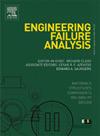A novel analytical approach for 3D stability of unsaturated soil slopes with cracks under rainfall infiltration
IF 4.4
2区 工程技术
Q1 ENGINEERING, MECHANICAL
引用次数: 0
Abstract
Rainwater infiltration in unsaturated soil slopes with crest cracks can trigger two distinct three-dimensional (3D) failure modes: shallow translational failure along the slope face and deep-seated rotational failure at the crack tip. This study employs the upper-bound limit analysis method to present an analytical framework for the 3D stability analysis of unsaturated soil slopes with cracks under rainfall infiltration. Two kinematically admissible failure mechanisms are constructed: a novel composite mechanism combining a 3D horn-shaped block with an oblique cylinder to characterize translational failure, accounting for boundary effects at slope crest, toe, and lateral constraints; and a rotational failure mechanism based on the horn-shaped block. The wetting front model is adopted to capture the transient process of rainwater infiltration. The proposed method enables a unified evaluation of both shallow and deep-seated stability for slopes with arbitrary crack depths at the crest, and its effectiveness is validated by existing literature. Parametric studies are conducted to investigate the effect of slope geometry (width-to-height ratio) on stability and the controlling factors of the translational and rotational failures.
降雨入渗作用下含裂缝非饱和土边坡三维稳定性分析新方法
雨水入渗在具有顶部裂缝的非饱和土边坡中会引发两种不同的三维破坏模式:沿坡面浅层平移破坏和裂缝尖端深层旋转破坏。本文采用上限分析方法,提出了降雨入渗条件下含裂缝非饱和土边坡三维稳定性分析的分析框架。构建了两种运动学允许的破坏机制:一种新型复合机构,将三维角状块与斜圆柱体结合在一起,用于表征平移破坏,考虑了坡顶、坡趾和侧向约束的边界效应;以及基于喇叭状块的旋转失效机构。采用湿润锋模型来捕捉雨水入渗的瞬态过程。该方法能够统一评价任意裂缝深度边坡的浅、深稳定性,并通过已有文献验证了其有效性。通过参数化研究,探讨了边坡几何形状(宽高比)对稳定性的影响以及平移和旋转破坏的控制因素。
本文章由计算机程序翻译,如有差异,请以英文原文为准。
求助全文
约1分钟内获得全文
求助全文
来源期刊

Engineering Failure Analysis
工程技术-材料科学:表征与测试
CiteScore
7.70
自引率
20.00%
发文量
956
审稿时长
47 days
期刊介绍:
Engineering Failure Analysis publishes research papers describing the analysis of engineering failures and related studies.
Papers relating to the structure, properties and behaviour of engineering materials are encouraged, particularly those which also involve the detailed application of materials parameters to problems in engineering structures, components and design. In addition to the area of materials engineering, the interacting fields of mechanical, manufacturing, aeronautical, civil, chemical, corrosion and design engineering are considered relevant. Activity should be directed at analysing engineering failures and carrying out research to help reduce the incidences of failures and to extend the operating horizons of engineering materials.
Emphasis is placed on the mechanical properties of materials and their behaviour when influenced by structure, process and environment. Metallic, polymeric, ceramic and natural materials are all included and the application of these materials to real engineering situations should be emphasised. The use of a case-study based approach is also encouraged.
Engineering Failure Analysis provides essential reference material and critical feedback into the design process thereby contributing to the prevention of engineering failures in the future. All submissions will be subject to peer review from leading experts in the field.
 求助内容:
求助内容: 应助结果提醒方式:
应助结果提醒方式:


